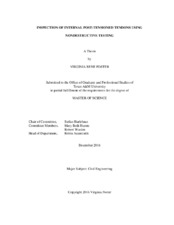| dc.description.abstract | Post-tensioned (PT) bridge systems have been used for many years and are generally favored by contractors and engineers. This is because they are economical, can be used for long spans, increase the structural capacity, and are fairly easy to construct. In these systems, the structural integrity of the PT tendons is critical. To protect the steel strands, a cementous grout material is injected into the ducts. However, the presence of grout voids in the tendons combined with the ingress of chlorides allows for corrosion of the steel strands. Additionally, the use of low-quality grout can cause extreme local pitting. This corrosion has a detrimental effect on the structural integrity of the bridge girder. Numerous tendon failures have occurred world-wide which have been attributed to these grout defects. The condition of the PT tendons must be monitored to ensure public safety. This research investigates the use of ultrasonic tomography (UST), ground penetrating radar (GPR), and infrared thermography (IRT) to evaluate the grout condition of internal PT tendons.
A 75-ft (22.86 m) bridge girder was constructed at the Texas A&M Riverside Campus. A complex defect design was developed and implemented. The defects include grout voids and water-filled cavities of varying sizes, as well as several grout conditions, including soft grout, unhydrated grout, and gassed grout. To test the capabilities and limitations of the various non-destructive testing (NDT) techniques, both metal and plastic ducts were utilized. The results suggest that UST may be able to identify sizeable water-filled cavities when metal ducts are utilized. However, strong reflections from plastic ducts make the grout defects unidentifiable. While GPR is able to detect the duct location, it is unable to identify any grout defects, regardless of the duct material. The internal ducts are embedded too deep into the girder walls for IRT to detect grout voids within the tendons. However, it showed promising results when inspecting the end caps, correctly identifying nearly 95% of grout voids in the anchorage regions. | en |


